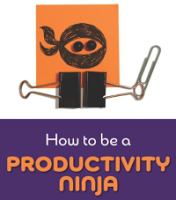So I snagged a copy (get your copy here) from Graham and the Think Productive team, where I found an entire section dedicated to Making Meeting Magic. Ok I’m sold.
The book excels from a practicality standpoint. I’ve read productivity books full of research, case studies and principles, yet I always find myself asking, “OK awesome! So what am I actually supposed to do?”
Not the case here.
Take these examples – here are three things you can try out in your meetings right away:
1. Rotate the Meeting Chair
This tip is simple – if you have a weekly project update meeting, change who runs the meeting each week. One week you’ll be the one taking notes and actions, tomorrow it’s someone else.
Now you’ve got shared ownership amongst everyone. And the same person isn’t stuck with the burden of doing all the work each time.
2. Get a Travel Notepad
Always have a pen & paper with you to capture notes from impromptu meetings like MBWA (Managing By Walking Around) or “water-cooler” conversations. The stylish solution is to get a Moleskine.
Me? I use a 3×5 index card.
Or you could just start a quick Huddle in Less Meeting on your iPad.
3. Make Decisions Before the Meeting
Let’s say we want to meet to propose a new budget. Before the meeting take a stab on what you think the budget should be (well researched, of course) and send it to the team for review.
Then use the actual meeting time to let the group react to your budget and have healthy debates about the estimate.
How to be a Meeting Ninja – Part 2
For all the practicality I’m still oddly craving the theoretical counterpart. I think there’s more to what Graham is telling us.
For example, making decisions before the meeting is a HUGE jump in how meetings are run.
It’s no longer: do some research, create a presentation, present at the meeting, have some cursory discussion, and then split off while the leader makes their decision behind closed doors.
Instead Graham explains that we should first do our research and make an initial decision, then send it to the team to review, and only after we’ve done that meet. Then when we meet we can have a real discussion about the initial decision and the leader can then make a more informed & vetted final decision.
How to be a Productivity Ninja is a great primer for having meetings and avoiding unnecessary ones. Now I want to the sequel that evaluates how we meet.
Attention-Tension Paradigm: Redefining How to Meet
Graham starts off the Meeting Ninja section explaining the Attention-Tension Paradigm. On the surface this is a super effective way to measure meeting quality. Pardon the hyperbole, but it’s also an opportunity to redefine how we meet.
First a quick explanation of the paradigm…
The Attention-Tension Paradigm is a matrix that plots Productivity as an output of two factors: Listening and Doing.
Meetings can of course then be plotted on this scale. For example, I had a post-mortem meeting awhile back about a project deployment gone wrong. We vented and created a long list of things we could have done differently. Yet no decision makers were involved and most of the solutions were impractical for our small team to do anything about, so nothing changed. In the end this meeting was just a group therapy session.
Or alternatively, what if during the deployment small pockets of individuals started making any code fix they could on the fly. Sure a ton of “things” would get done, but it would be directionless, wouldn’t have been communicated to any of our integrating systems, and would have left us in a worse place than we started. Doing for the sake of doing solves no problem.
The goal is to eliminate all unproductive meetings while learning how to have productive ones. So what is a productive meeting? Here’s my definition:
A productive meeting is one that adequately balances Doing & Listening – or put another way, Strategy & Tactics – such that it supports one or more steps of the following problem-solving process:
- A solution strategy is defined and agreed to,
- A set of tasks are laid out to get you from the present to the end goal,
- The tasks are given owners & dates,
- And the tasks are followed up on until they’re done.
The crazy thing is that we can boil down the myriad of meeting types into a combination of these two factors – Tactical and Strategic – to see if a meeting is productive or should be cancelled.
Stop Presenting In Meetings
Meetings are no longer simply about communication. Historically that made sense, but modern technology and the communication channels available (email, phone, video chat, Wikis, SMS, IM, Twitter, faxes even!) mean information sharing should happen before the meeting. The meeting is when you react to, debate, and adjust to that information.
I can’t resist comparing this to the changes in the education space. The Kahn Academy has reinvented education by moving information sharing (i.e. the Lecture) from the classroom to being the homework assignment. In its place the the classroom is now reserved for working through problems as teams or with the teacher, doing what used to be the homework.
And now other questions start flowing…How should you have a Tactical meeting?…A Strategic meeting?…Which meetings does this mean we can get rid of?…What does it mean to share information before the meeting?
Hmmm…sounds like an idea for some future posts.
Thanks Graham for the great book. And the inspiration to redefine what a meeting is in today’s world.
Ready to start having productive meetings now? Less Meeting lets you easily share information before the meeting. That way you can spend your meeting debating decisions and tracking action items.







